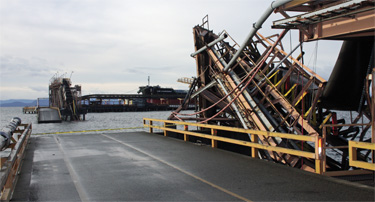Inadequate communication between the pilot and master about approaching the docking basin or abort points in the voyage led to a bulk carrier crashing into a British Columbia coal terminal in 2012, Canada’s Transportation Safety Board (TSB) said.
Cape Apricot struck the Roberts Bank terminal Dec. 7, 2012, demolishing a causeway and conveyor system. The 939-foot, 90,091-gt vessel was conducted by a pilot and assisted by two tugs when it struck the terminal. Due to the impact, the causeway and conveyor collapsed into the water, and the ship’s bow sustained damage. There was minor pollution and no injuries.
In its findings, the TSB determined that though the pilot and master discussed the vessel’s passage and completed the necessary documentation for the pilot-master exchange, Cape Apricot’s course to Roberts Bank placed the vessel in a direct line of approach to the trestle.
“This path required a tight alteration of course to starboard, but given the vessel’s speed and direct approach, the Cape Apricot’s turn to starboard was neither timely nor sufficient, and the vessel struck the trestle,” the TSB report states.
As Cape Apricot was proceeding toward Roberts Bank just before midnight on Dec. 6, the pilot ordered a direct course toward the entrance of the basin. The 327° True approach required a course alteration of about 65° to starboard for the turn into the basin. This course was more direct than other approaches made by vessels docking at Berth 2 that same year. The other courses, which were less direct, required a smaller course alteration to enter the basin.
With this direct course, more time and space were necessary to execute the turn into the basin than would be required for less direct angles of approach.
The TSB wrote that “the turn was initiated between 1.9 to 0.5 cables from the transit line into the basin; however, the turning circle of the vessel, given its speed, would have required a minimum distance of 3.2 to 3.6 cables to the transit line. Furthermore, the pilot had stopped the engine, reducing the effectiveness of the rudder, and the turn was not initiated at an adequate distance in order to complete it using only the vessel’s rudder.”
The report noted that as the vessel approached the basin, the master did not seek clarification or question the pilot, nor had the pilot established or communicated any abort points.
“Without effective communication regarding their shared mental model during the approach, the master and the pilot did not identify the developing risk as the maneuver progressed, and did not take timely corrective action,” said the report.
The TSB investigation determined that the voyage data recorder (VDR) had stopped working prior to the striking because of a defective hard disk drive. As a result, there was no data relating to the occurrence.
Responsibility for the operation, maintenance and administration of pilot services for compulsory pilotage areas on Canada’s west coast lies with the Pacific Pilotage Authority (PPA). The PPA does not directly employ pilots, other than those operating in the Fraser River. Rather, the PPA contracts the British Columbia Coast Pilots Ltd. (BCCP) to provide pilotage services for vessels along the B.C. coast.
The TSB says that a safety management system (SMS) enables risks to be identified, analyzed and mitigated. Neither the PPA nor the BCCP has a comprehensive SMS, the report indicated. The investigation determined that neither the PPA nor the BCCP has a formal risk assessment process or an accident/incident review process for pilots to ensure bridge resource management best practices are in place throughout a voyage.
Given the vessel’s speed and direct approach, the pilot initiated the turn at an insufficient distance from the trestle and the pilot had not ensured that both tugs were ready to assist with the turn prior to the vessel’s arrival at the basin, according to the TSB’s findings.
As there were no established abort points planned or discussed, the report said the master and the pilot failed to put themselves in a proper position to mitigate any dangers that would arise if the ship went off-course during the approach.
In its findings as to risk, TSB said that without a safety management system in place, pilotage organizations may not properly identify hazards and mitigate them, thereby placing vessels at risk.
The TSB noted also that if VDR data, in particular bridge audio recordings, are not available to an investigation, this may preclude the identification and communication of safety deficiencies in order to advance transportation safety.
Without VDR data, the data from the portable pilot unit was integral to the investigation.
As a result of this occurrence, the PPA developed a post-incident protocol that identifies what actions are to be taken.
In a statement, the B.C. pilots said they are reviewing the TSB’s report.
“BCCP will work collaboratively with the Pacific Pilotage Authority to continually assess and improve where necessary safety practices, while maintaining flexibility for pilots to fulfill their duties and to make decisions based on environmental and marine conditions,” the statement said.
Professional Mariner was unable to contact Cape Apricot owner Leo Ocean SA in Imabari-shi, Japan.

